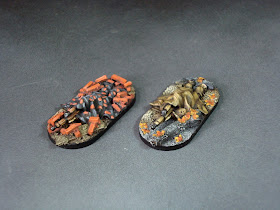Here’s a few snipers from the Great War I’ve worked on this week. I’ve painted a few snipers before and I’ve always found them an interesting subject. It gives a painter the chance to experiment a little more than you get with painting the more familiar uniforms of British and German front line troops.
The first figure is from Great War Miniatures – the British sniper by the tree – with the other three being from 1st Corps miniatures – the other standing and two prone snipers. I enjoyed painting them all. There were each finely cast and take paint very well. I particularly like the prone snipers, and I would say that they’d be perfect for a lot more than just the Western Front in the First World War (which is the range their sold in by 1st Corps).
As for the camouflage, the Great War saw some real innovations in this area. Accordingly to “Sniping in the Great War” by Martin Pegler (at page 131) the ghillie suit, worn by the Lovat Scouts, was one of these: “Sewn onto it were lengths of green, brown or black cloth, as well as loops into which local flora would be tucked, suitably blurring the outline of the human body. It had a hood that could be pulled up to cover the forehead, and properly used could make a man invisible to a skilled observer at 10 yards”. As the War progressed, snipers made their own camouflage from whatever was available: “muslin, wire gauze, coats, gloves, veils, bandages for rifles, periscopes etc...masks...may be useful. An ordinary sandbag over the head, with the strands pulled apart...for the eyes is often the simplest and best disguise”. (“Sniping in the Great War”, page 141).
I tried to set the British snipers in a wooded environment, crouching among the shattered stumps and fallen branches.
Turning to the German snipers, I wanted to set these in a built up environment such as a ruined village or a particular battlefield such as the infamous “brickstacks” around Cuinchy (the site of a former brickworks, marked by numerous solid and sturdy stacks of bricks varying in height up to around 18 feet and held by the Germans in 1915 and 1916). In the early stages of the War, German snipers had a distinct upper-hand. With unfettered access to high quality telescopic sights through their optics and precision manufacturing infantry, the German Army was also quick to field snipers along the whole of their front line. Few British officers in 1914 were fully aware of the need to provide adequate protection against sniper fire: “October 1914: C Company was also under inescapable enfilade from Rouges Bancs, which was only 350 yards away…for most of the deaths were from rifle fire, shells caused comparatively few.” (“Sniping in the Great War”, page 49)
So, here’s the two snipers, painted in camouflage aimed to conceal then among shattered walls and buildings. As the British used netting and canvas covers replicating ruined buildings and fallen bricks, I couldn’t see why the Germans would not have had access to the same sort of camouflage.
Next up, I’ve some British sentries, German trench raiders and terrain over the Easter holidays, together with a few other posts I’ve been saving for a while. Until then, Happy Easter!








Excellent work, Sidney
ReplyDeleteIndeed great work. I bought the 1st Corps snipers some time ago, now I have some good inspirational materials to recue them from the painting pile
ReplyDeleteGreat qoek, Sidney. I have to confess to nevrr having painted up any WW1 sniper figures. Must give it a go. A couple of interesting sniper cammo suits are on permanebt display at the Imperial War Museum. Very basic... daubed with paint.
ReplyDeleteA splendid post Sidney and great work on these miniatures.
ReplyDeleteVery good painting Sidney !!! Most impressive !
ReplyDeletebest regards dalauppror
Fantastic brushwork, especially the German's!!
ReplyDelete!! They had brick pattern cammo sheets!? Amazing..thanks for that one..I´ve learned something new :-D
ReplyDeleteCracking painting....
I read an article about a WWI sniper..took him 8 hours to crawl 20 yards, fired one shot and took him 10 hours to inch back. He also mentioned taking two rifles in case one (for whatever reason) jammed or the round didn´t fire and it would be quieter to slowly exchange rifles than risk making a noise by ejecting the round.
Cheers
Paul
Superb brushwork as well as excellent background information!
ReplyDeleteChristopher
Wonderful work here Sidney. Lovely painting and great info too.
ReplyDeleteLovely vignettes, Sidney. I particularly like the shattered trees and leaves on the British stands - an odd thing to capture your attention, but there you go. Question: What are the dimensions of the pill-shaped bases that you use?
ReplyDeleteBest,
Curt
Very fine work. I have seen a sniper stand up 10m from me where previously I had just seen grass and scrub. A truly eerie experience.
ReplyDeleteDo you know Joseph Boyden's novel Three Day Road? It's about two Canadian Indians who go to the Great War as snipers. Very moving book.
Another superb addition to your collection.
ReplyDeleteBeautiful. I'm always awed by your creativity and artistry.
ReplyDeleteSpiffing stuff!
ReplyDeleteWell done.
Matt
Lovely work, for additional ideas may I recommend "Fieldcraft, Sniping and Intelligence" by Major Nevill Armstrong. He ran the Second Army School of Sniping 1915-16 and the Canadian Corps School of Scouting, Observation and Sniping 1917-18. A most interesting work covering amongst other things, the use of hides. (Published 1942, well my copy is!)Lots of useful ideas for modelling figures.
ReplyDeleteM. J. Ney
Fecking brilliant!
ReplyDeleteExcellent, Sidney
ReplyDeleteSimply awesome! Are you doing a demo game Saturday btw?
ReplyDelete